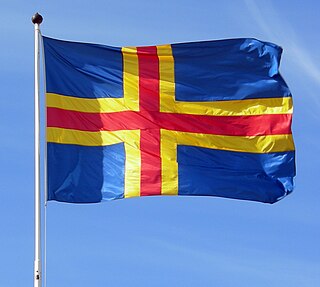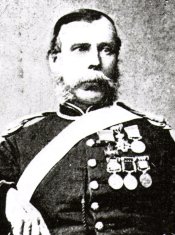1854 (MDCCCLIV) was a common year starting on Sunday of the Gregorian calendar and a common year starting on Friday of the Julian calendar, the 1854th year of the Common Era (CE) and Anno Domini (AD) designations, the 854th year of the 2nd millennium, the 54th year of the 19th century, and the 5th year of the 1850s decade. As of the start of 1854, the Gregorian calendar was 12 days ahead of the Julian calendar, which remained in localized use until 1923.

The Crimean War was fought from October 1853 to February 1856 between Russia and an ultimately victorious alliance of the Ottoman Empire, France, the United Kingdom and Sardinia-Piedmont.

Lewes is the county town of East Sussex, England. The town is the administrative centre of the wider district of the same name and the location of East Sussex County Council at the county hall.

The history of Åland can be traced back to roughly 4000 BCE, when humans first reached the archipelago in the Neolithic period. Several Bronze Age villages have been found on Åland. During the Viking Age, six hillforts were built. Sweden occupied the Åland Islands from the 1200s until 1809, during which, Kastelholm Castle was the focal point of many battles. In 1809, the Russian empire took Åland and Finland. In 1854, British and French forces attacked Bomarsund. The Åland Islands were then demilitarised until 1906. In 1918, Swedish and German forces occupied the Åland Islands. After the Finnish Civil War, Åland joined Finland following the Åland Convention of 1921.

Sund is a municipality of Åland. It is an autonomous territory of Finland which is very rich in history and culture, being one of the official 27 National landscapes of Finland.

The Grand Duchy of Finland, also translated as Grand Principality of Finland, was the predecessor state of modern Finland. It existed between 1809 and 1917 as an autonomous part of the former Russian Empire.

The Battle of Bomarsund, in August 1854, took place during the Åland War, which was part of the Crimean War, when an Anglo-French expeditionary force attacked a Russian fortress. It was the only major action of the war to take place at Bomarsund in the Baltic Sea.

Rear Admiral Charles Davis Lucas was an Irish-born Royal Navy officer who was the first person to win the Victoria Cross, the highest award for gallantry in the face of the enemy that can be awarded to British and Commonwealth forces. He rose to the rank of rear admiral during his time in the navy.

Peter Leitch VC was a Scottish recipient of the Victoria Cross (VC), the highest and most prestigious award for gallantry in the face of the enemy that can be awarded to British and Commonwealth forces.

The siege of Sevastopol lasted from October 1854 until September 1855, during the Crimean War. The allies landed at Eupatoria on 14 September 1854, intending to make a triumphal march to Sevastopol, the capital of the Crimea, with 50,000 men. Major battles along the way were Alma, Balaklava, Inkerman, Tchernaya, Redan, and, finally, Malakoff. During the siege, the allied navy undertook six bombardments of the capital, on 17 October 1854; and on 9 April, 6 June, 17 June, 17 August, and 5 September 1855.

The Baltic Medal was a campaign medal approved on 6 June 1856, for issue to officers and men of the Royal Navy, Royal Marines, and Royal Sappers and Miners who served between March 1854 and August 1855 in the Baltic Sea operations against Russia in the Baltic theatre of the Crimean War, or Åland War. The medal primarily covered naval actions but was also awarded to 106 men of the Royal Sappers and Miners who were landed to place demolition charges against Russian fortifications at Bomarsund and Sveaborg.

Kastelholm Castle is a Swedish-built medieval castle located off Road 2 in Sund, Åland, Finland, approximately 25 kilometres (16 mi) northeast of Mariehamn, overlooking a fjord to the south of the village of Kastelholm. Along with Hämeenlinna, Olavinlinna in Savonlinna, Raseborg, and Turku, Kastelholm is one of only five surviving Finnish medieval fortresses that are also considered to be architecturally substantial. Built in the 14th century, and held in fief during the Middle Ages by various nobles, feudal chiefs, and kings, it had significant period in the 15th and 16th centuries.
Events from the year 1854 in the United Kingdom.

Haydarpaşa Cemetery, also known as Haidar Pasha Cemetery, Istanbul,, located in the Haydarpaşa neighborhood of Üsküdar district in the Asian part of Istanbul, Turkey, is a burial ground established initially for British military personnel who took part in the Crimean War (1854–1856). The cemetery holds also graves of Commonwealth soldiers from the two World Wars, and civilians of British nationality.

The Battle of Suomenlinna was fought on 9–11 August 1855 between Russian defenders and a joint British/French fleet during the Åland War. It was a part of the Crimean War.

The Church of St John sub Castro is an Anglican church in Lewes, the county town of East Sussex, England. It was built in 1839 on the site of an 11th-century Saxon church, and has been designated by English Heritage as a Grade II listed building. In the churchyard is a memorial to Finnish prisoners from the Crimean War who died while confined in Lewes Naval Prison; the memorial is also listed Grade II. The church continues to be active as a parish church in the diocese of Chichester.

The Finnish Prisoner is an opera by Orlando Gough set to an English-language libretto written by Stephen Plaice who based it on the true story of Finnish prisoners of war incarcerated in England during the Åland War, part of the Crimean War.

The Sebastopol Monument is a triumphal arch that is located in the Old Burial Ground, Halifax, Nova Scotia, Canada. The arch commemorates the Siege of Sevastopol (1854–1855), which is one of the classic sieges of all times. This arch is the 4th oldest war monument in Canada (1860). It is the only monument to the Crimean War in North America. The arch and lion were built in 1860 by stone sculptor George Lang to commemorate British victory in the Crimean war and the Nova Scotians who had fought in the war.

Prästö is an island in the municipality of Sund in Åland, Finland. It is connected to the Åland Mainland by the Bomarsund Bridge crossing the narrow Bomarsund Strait. Prästö is located next to the ruins of the Bomarsund Fortress, the place of the 1856 Crimean War Battle of Bomarsund. The island is known of its rich military history, especially of the six Russian military cemeteries established in the 19th century. Because of the graveyards, Prästö was once known as the ″Island of the Dead″.

The Åland War is the Finnish term for the operations of a British-French naval force against military and civilian facilities on the coast of the Grand Duchy of Finland in 1854–1856, during the Crimean War between the Russian Empire and the allied France and Britain. The war is named after the Battle of Bomarsund in Åland. Although the name of the war refers to Åland, skirmishes were also fought in other coastal towns of Finland in the Gulf of Bothnia and the Gulf of Finland.


















